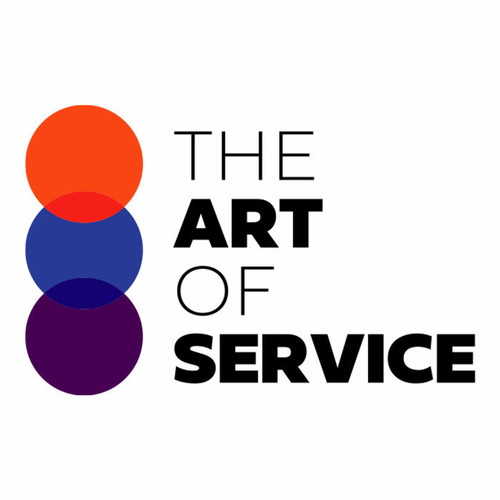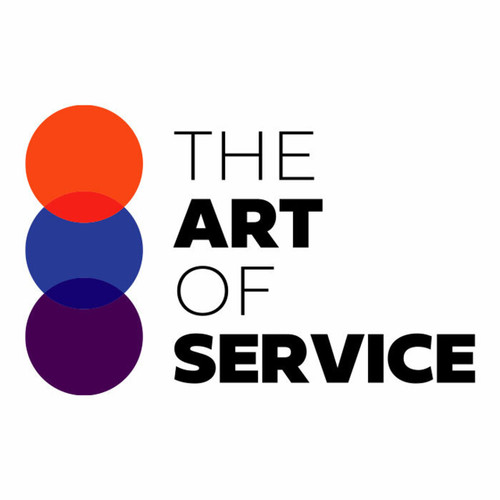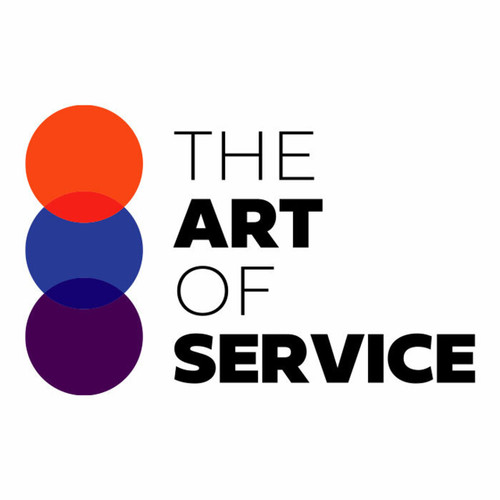Our comprehensive dataset is designed specifically for professionals like you who are looking for efficient and effective solutions to ensure the accuracy and relevance of your data.
With over 1500 prioritized requirements, you can confidently identify and address urgent issues as they arise.
But our dataset doesn′t just stop at providing requirements.
We also offer solutions, benefits, results, and real-life case studies to give you a holistic understanding of how data validation and obsolescence can impact your business.
What sets us apart from our competitors and other alternatives in the market? Our knowledge base is curated by industry experts and constantly updated with the latest research and advancements in data validation and obsolescence.
With our dataset, you can stay ahead of the curve and make informed decisions for your business.
Our product is user-friendly and accessible for DIY users, saving you the cost and hassle of expensive consultants or software.
And with a thorough product detail and specification overview, you can easily understand how to use our dataset to its full potential.
Don′t waste any more time trying to piece together information from various sources.
Our Data Validation and Data Obsolescence Knowledge Base offers a one-stop-shop for all your data needs.
Take advantage of this invaluable tool and watch your business thrive.
Investing in our dataset means investing in the success of your business.
Say goodbye to errors, delays, and wasted resources.
With the right data validation and obsolescence strategies in place, you can confidently move forward with your business goals.
But don′t just take our word for it, try it out for yourself!
Our dataset is suitable for businesses of all sizes and budgets.
You′ll be amazed at the positive impact it can have on your bottom line.
Don′t get left behind in today′s fast-paced and data-driven world.
Stay ahead of the game with our Data Validation and Data Obsolescence Knowledge Base.
Get your hands on the most essential questions, proven solutions, and real-life examples that will give you a competitive edge and ensure the success of your business.
Don′t wait any longer, invest in our dataset now and unlock its full potential!
Discover Insights, Make Informed Decisions, and Stay Ahead of the Curve:
Key Features:
Comprehensive set of 1502 prioritized Data Validation requirements. - Extensive coverage of 110 Data Validation topic scopes.
- In-depth analysis of 110 Data Validation step-by-step solutions, benefits, BHAGs.
- Detailed examination of 110 Data Validation case studies and use cases.
- Digital download upon purchase.
- Enjoy lifetime document updates included with your purchase.
- Benefit from a fully editable and customizable Excel format.
- Trusted and utilized by over 10,000 organizations.
- Covering: Backup And Recovery Processes, Data Footprint, Data Architecture, Obsolete Technology, Data Retention Strategies, Data Backup Protocols, Migration Strategy, Data Obsolescence Costs, Legacy Data, Data Transformation, Data Integrity Checks, Data Replication, Data Transfer, Parts Obsolescence, Research Group, Risk Management, Obsolete File Formats, Obsolete Software, Storage Capacity, Data Classification, Total Productive Maintenance, Data Portability, Data Migration Challenges, Data Backup, Data Preservation Policies, Data Lifecycles, Data Archiving, Backup Storage, Data Migration, Legacy Systems, Cloud Storage, Hardware Failure, Data Modernization, Data Migration Risks, Obsolete Devices, Information Governance, Outdated Applications, External Processes, Software Obsolescence, Data Longevity, Data Protection Mechanisms, Data Retention Rules, Data Storage, Data Retention Tools, Data Recovery, Storage Media, Backup Frequency, Disaster Recovery, End Of Life Planning, Format Compatibility, Data Disposal, Data Access, Data Obsolescence Planning, Data Retention Standards, Open Data Standards, Obsolete Hardware, Data Quality, Product Obsolescence, Hardware Upgrades, Data Disposal Process, Data Ownership, Data Validation, Data Obsolescence, Predictive Modeling, Data Life Expectancy, Data Destruction Methods, Data Preservation Techniques, Data Lifecycle Management, Data Reliability, Data Migration Tools, Data Security, Data Obsolescence Monitoring, Data Redundancy, Version Control, Data Retention Policies, Data Backup Frequency, Backup Methods, Technology Advancement, Data Retention Regulations, Data Retrieval, Data Transformation Tools, Cloud Compatibility, End Of Life Data Management, Data Remediation, Data Obsolescence Management, Data Preservation, Data Management, Data Retention Period, Data Legislation, Data Compliance, Data Migration Cost, Data Storage Costs, Data Corruption, Digital Preservation, Data Retention, Data Obsolescence Risks, Data Integrity, Data Migration Best Practices, Collections Tools, Data Loss, Data Destruction, Cloud Migration, Data Retention Costs, Data Decay, Data Replacement, Data Migration Strategies, Preservation Technology, Long Term Data Storage, Software Migration, Software Updates
Data Validation Assessment Dataset - Utilization, Solutions, Advantages, BHAG (Big Hairy Audacious Goal):
Data Validation
Data validation involves checking the accuracy and completeness of data to ensure it is current and reliable.
1. Regular data audits and updates ensure accuracy and relevancy in a rapidly changing environment.
Benefits: Up-to-date and reliable data for decision making.
2. Implement automated validation processes to quickly identify and correct outdated data.
Benefits: Increased efficiency and reduced human error.
3. Implement a data retention policy to prioritize important information and discard obsolete data.
Benefits: Reduced clutter and improved data organization.
4. Utilize data backup systems to preserve historical information and protect against loss of data.
Benefits: Availability of previous data for reference and analysis.
5. Invest in current technology and systems to prevent data obsolescence.
Benefits: Better compatibility and durability of data.
6. Engage data management professionals to regularly review and analyze data for any potential obsolescence.
Benefits: Identification of potential issues and timely resolution.
7. Encourage ongoing training and education for employees to stay updated on current data practices.
Benefits: Improved data management skills and awareness of potential obsolescence.
8. Collaborate with other organizations in the industry to share and update outdated data.
Benefits: Access to a wider pool of up-to-date data.
9. Implement a data archiving system to store and access older, but potentially useful, data.
Benefits: Preservation of historical data for future analysis.
10. Develop and implement a data obsolescence plan to assess and address potential obsolescence risks.
Benefits: Proactive approach towards managing data obsolescence.
CONTROL QUESTION: Have you are surveyed the employees recently to ensure this data is up to date?
Big Hairy Audacious Goal (BHAG) for 10 years from now:
By 2030, our company will have implemented a comprehensive data validation strategy that includes regular surveys of employees to ensure the accuracy and relevancy of all our data. This will not only streamline our operations and decision-making processes, but also increase trust and transparency within our organization and with our stakeholders. As a result, we will be known as a leader in data integrity and continue to drive innovation and growth for years to come.
Customer Testimonials:
"I`m thoroughly impressed with the level of detail in this dataset. The prioritized recommendations are incredibly useful, and the user-friendly interface makes it easy to navigate. A solid investment!"
"The diversity of recommendations in this dataset is impressive. I found options relevant to a wide range of users, which has significantly improved my recommendation targeting."
"I`m blown away by the value this dataset provides. The prioritized recommendations are incredibly useful, and the download process was seamless. A must-have for data enthusiasts!"
Data Validation Case Study/Use Case example - How to use:
Client Situation:
ABC Corporation is a multinational corporation with over 10,000 employees across various locations. The company has been in operation for the past 30 years and has experienced significant growth during this period. Due to this growth, the HR department was struggling to keep track of employee data, resulting in outdated and inaccurate information. This posed a serious problem for the company as it hindered their decision-making process and compromised the accuracy of their reporting. Additionally, there were concerns about security and compliance risks associated with having outdated employee data. This prompted the HR department to seek the help of a consulting firm to ensure the accuracy and completeness of their employee data.
Consulting Methodology:
Upon being approached by ABC Corporation, our consulting firm conducted an initial assessment to understand the scope of the problem and the potential impact on the organization. It was identified that the inaccurate and outdated employee data was due to a lack of a proper data validation process. Consequently, we proposed a comprehensive data validation project to ensure the accuracy and completeness of employee data. The following are the key steps involved in our methodology:
1. Understanding the current state: We conducted interviews with key stakeholders to understand the current state of the employee data within the organization. This included understanding the data sources, systems, and processes involved in managing employee data.
2. Defining data validation requirements: Based on the understanding of the current state, we defined the specific data validation requirements for ABC Corporation. This included identifying the critical data elements, data sources, and data quality standards.
3. Designing a data validation process: We designed a customized data validation process for ABC Corporation, which included data cleaning, data matching, and data enrichment techniques. This process was tailored to meet the specific requirements of the company and ensure the accuracy and completeness of the data.
4. Implementation: The data validation process was implemented in collaboration with the HR department. Our team provided training to the HR staff on how to use the data validation tools and techniques effectively.
5. Continuous monitoring: To maintain the accuracy of employee data, we established a continuous monitoring process to identify and address any data quality issues that may arise in the future. This involved setting up automated checks and alerts to identify potential data anomalies.
Deliverables:
1. Data validation process document: A detailed document outlining the data validation process, including data sources, tools, and validation techniques.
2. Automated data validation tools: Customized data validation tools and dashboards were provided to aid in the validation process.
3. Training materials: Training material on the usage of data validation tools and techniques was provided to the HR staff to ensure they were equipped to manage and maintain the quality of the data.
4. Data validation reports: Regular reports were provided to the HR department to highlight any data quality issues identified and the steps taken to address them.
Implementation Challenges:
The implementation of the data validation process faced several challenges, including resistance from some employees, budget constraints, and technical issues in integrating data from legacy systems. Additionally, there was a lack of awareness within the organization on the importance of data validation, which made gaining buy-in challenging.
Key Performance Indicators (KPIs):
1. Reduction in data errors: One of the key KPIs for the project was to measure the reduction in data errors after the implementation of the data validation process. This was tracked by comparing the number of data errors before and after the implementation.
2. Improved data completeness: The completeness of employee data was another critical KPI. This was measured by the number of missing data fields before and after the data validation process.
3. Time savings: The time saved in manual data entry and correction was measured to demonstrate the effectiveness of the data validation process.
Management Considerations:
1. Change management: Since the implementation of the data validation process involved a change in the way data was managed, effective change management was essential. Regular communication and training were provided to gain buy-in from all stakeholders.
2. Compliance and regulatory requirements: The data validation process had to be compliant with various regulatory and compliance requirements surrounding the handling of employee data. This was taken into consideration while designing the process.
3. Data privacy and security: As the data validation process involved handling sensitive employee data, strict security measures and protocols were put in place to ensure data privacy and security.
Conclusion:
In conclusion, the implementation of a comprehensive data validation process resulted in significant improvements in the quality of employee data at ABC Corporation. The customized data validation process, continuous monitoring, and KPIs helped ensure the accuracy and completeness of the data. This, in turn, has enabled the organization to make more informed decisions and comply with regulatory requirements. The project highlighted the importance of having an effective data validation process in place to ensure accurate and reliable data, which is crucial for any organization′s success.
Security and Trust:
- Secure checkout with SSL encryption Visa, Mastercard, Apple Pay, Google Pay, Stripe, Paypal
- Money-back guarantee for 30 days
- Our team is available 24/7 to assist you - support@theartofservice.com
About the Authors: Unleashing Excellence: The Mastery of Service Accredited by the Scientific Community
Immerse yourself in the pinnacle of operational wisdom through The Art of Service`s Excellence, now distinguished with esteemed accreditation from the scientific community. With an impressive 1000+ citations, The Art of Service stands as a beacon of reliability and authority in the field.Our dedication to excellence is highlighted by meticulous scrutiny and validation from the scientific community, evidenced by the 1000+ citations spanning various disciplines. Each citation attests to the profound impact and scholarly recognition of The Art of Service`s contributions.
Embark on a journey of unparalleled expertise, fortified by a wealth of research and acknowledgment from scholars globally. Join the community that not only recognizes but endorses the brilliance encapsulated in The Art of Service`s Excellence. Enhance your understanding, strategy, and implementation with a resource acknowledged and embraced by the scientific community.
Embrace excellence. Embrace The Art of Service.
Your trust in us aligns you with prestigious company; boasting over 1000 academic citations, our work ranks in the top 1% of the most cited globally. Explore our scholarly contributions at: https://scholar.google.com/scholar?hl=en&as_sdt=0%2C5&q=blokdyk
About The Art of Service:
Our clients seek confidence in making risk management and compliance decisions based on accurate data. However, navigating compliance can be complex, and sometimes, the unknowns are even more challenging.
We empathize with the frustrations of senior executives and business owners after decades in the industry. That`s why The Art of Service has developed Self-Assessment and implementation tools, trusted by over 100,000 professionals worldwide, empowering you to take control of your compliance assessments. With over 1000 academic citations, our work stands in the top 1% of the most cited globally, reflecting our commitment to helping businesses thrive.
Founders:
Gerard Blokdyk
LinkedIn: https://www.linkedin.com/in/gerardblokdijk/
Ivanka Menken
LinkedIn: https://www.linkedin.com/in/ivankamenken/







